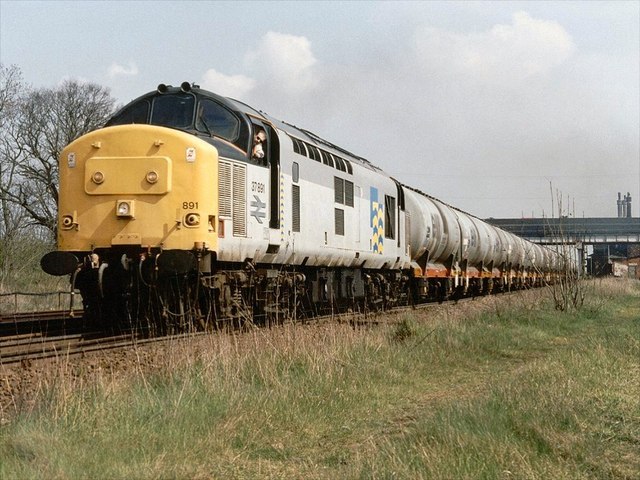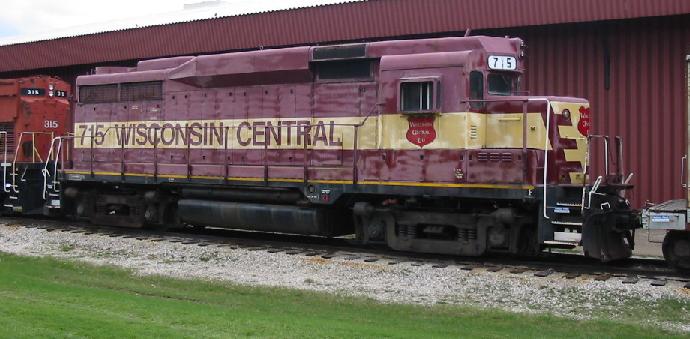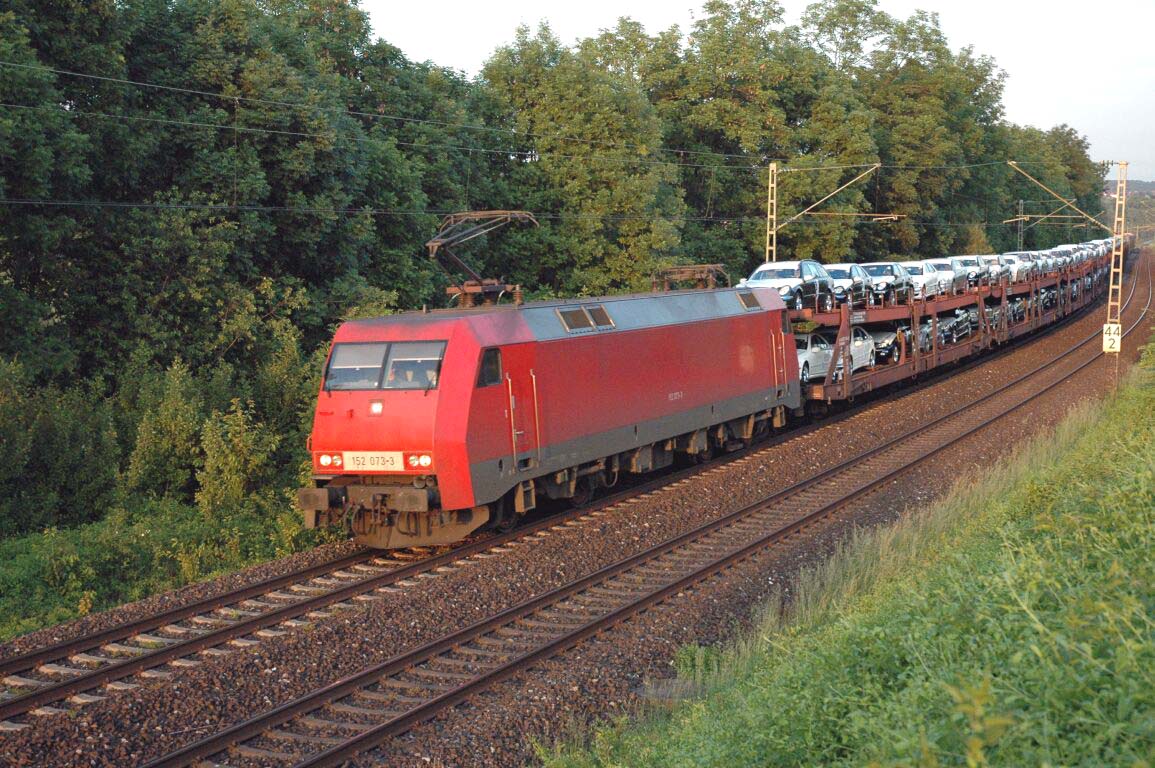|
Trainload Freight
Trainload Freight was the sector of British Rail responsible for trainload freight services. The division was subdivided into four sub-sectors; coal, petroleum, metals and construction. It was formed in 1988 from the trainload operations of British Rail's Railfreight division. The company existed until 1994, when, as part of the privatisation process of British Rail, it was split into three separate companies by region: Load-Haul, Mainline Freight and Trans-Rail. History Trainload Freight (TLF) was created in 1988 as the sector of British Rail responsible for operating unit trains. The division was subdivided into four sub-sectors according to cargo carried: Coal, Construction, Metals, and Petroleum. Other wagonload freight activities and containerised freight were organised in the Railfreight Distribution (RfD) division at the same time. The trainload business represented approximately 80% of British Rail's total revenue from freight, and 90% of freight traffic by mass. Trai ... [...More Info...] [...Related Items...] OR: [Wikipedia] [Google] [Baidu] |
Railfreight Coal Logo
Railfreight was a sector of British Rail responsible for all freight operations on the British network. The division was created in 1982 when BR sought to assign particular stock and management to the evolving requirements of freight traffic. History Railfreight existed as a single unit from 1982 until 1987 as the rail freight division of British Rail. In 1987 BRs freight operations were further divided according to the type of train operated and material carried; the Trainload Freight division and its sub-sectors handled unit trains of coal, metal, aggregates, oil or petroleum, LPG, petro-chemicals, and construction materials, Railfreight Distribution handled intermodal and non-unit train work, and channel tunnel freight. Activities which were not assigned to one of the new ''Trainload Freight'' or ''Railfreight Distribution'' sub-sectors were then continued under the Railfreight General banner, Railfreight General was dissolved in 1989, its limited responsibilities being t ... [...More Info...] [...Related Items...] OR: [Wikipedia] [Google] [Baidu] |
British Rail Class 60
The British Rail Class 60 is a class of Co-Co heavy freight diesel-electric locomotives built by Brush Traction. They are nicknamed ''Tugs'' by rail enthusiasts. During the 1980s, it became increasingly apparent that British Rail required a more capable Type 5 locomotive for its heavy freight trains. Dissatisfaction with the British Rail Class 56's reliability led to the stipulation of a 95 percent availability, a stringent requirement at the time. A total of three bids were received to a competitive tender issued on 10 August 1987; of these, Brush Traction's submission was selected and an order for 100 locomotives was issued during the following year. Despite the first example being completed during June 1989, due to a number of technical issues discovered during testing, the first examples of the Class 60 would not enter revenue service until late 1990. Operated only during the final years of British Rail, the entire Class 60 fleet became the property of English Welsh & Sco ... [...More Info...] [...Related Items...] OR: [Wikipedia] [Google] [Baidu] |
37603 And 37604 At Clapham Junction
__NOTOC__ Year 376 ( CCCLXXVI) was a leap year starting on Friday (link will display the full calendar) of the Julian calendar. At the time, it was known as the Year of the Consulship of Valens and Augustus (or, less frequently, year 1129 '' Ab urbe condita''). The denomination 376 for this year has been used since the early medieval period, when the Anno Domini calendar era became the prevalent method in Europe for naming years. Events By place Roman Empire * Gothic War: Emperor Valens permits the Visigothic chieftain Fritigern and his people to cross the Danube from Thrace (later Romania), and settle on Roman soil in Lower Moesia, on the condition that they provide soldiers to the legions. The Visigoths embark by troops on boats and rafts, and canoes made from hollowed tree trunks. The river is swollen by frequent rains; a large number try to swim and are drowned in their struggle against the force of the stream. * The Greuthungi, led by Alatheus and Saphrax, dis ... [...More Info...] [...Related Items...] OR: [Wikipedia] [Google] [Baidu] |
British Rail Class 37
The British Rail Class 37 is a diesel-electric locomotive. Also known as the English Electric Type 3, the class was ordered as part of the British Rail modernisation plan. They were numbered in two series, D6600–D6608 and D6700–D6999. The Class 37 became a familiar sight on many parts of the British Rail network, in particular forming the main motive power for InterCity services in East Anglia and within Scotland. They also performed well on secondary and inter-regional services for many years. Many are still in use today on freight, maintenance, and empty stock movement duties. The Class 37s are known to some railway enthusiasts as "tractors", a nickname given due to the similarities between the sound of the Class 37's engine and that of a tractor. Description Background As part of the large scale dieselisation brought about by the British Rail modernisation plan a need was identified for a number of type 3 locomotives of power output to . English Electric had alre ... [...More Info...] [...Related Items...] OR: [Wikipedia] [Google] [Baidu] |
Railfreight 20132
Railfreight was a sector of British Rail responsible for all freight operations on the British network. The division was created in 1982 when BR sought to assign particular stock and management to the evolving requirements of freight traffic. History Railfreight existed as a single unit from 1982 until 1987 as the rail freight division of British Rail. In 1987 BRs freight operations were further divided according to the type of train operated and material carried; the Trainload Freight division and its sub-sectors handled unit trains of coal, metal, aggregates, oil or petroleum, LPG, petro-chemicals, and construction materials, Railfreight Distribution handled intermodal and non-unit train work, and channel tunnel freight. Activities which were not assigned to one of the new ''Trainload Freight'' or ''Railfreight Distribution'' sub-sectors were then continued under the Railfreight General banner, Railfreight General was dissolved in 1989, its limited responsibilities being t ... [...More Info...] [...Related Items...] OR: [Wikipedia] [Google] [Baidu] |
British Rail Class 20
The British Rail Class 20, otherwise known as an English Electric Type 1, is a class of diesel-electric locomotive. In total, 228 locomotives in the class were built by English Electric between 1957 and 1968, the large number being in part because of the failure of other early designs in the same power range to provide reliable locomotives. The locomotives were originally numbered D8000–D8199 and D8300–D8327. They are known by railway enthusiasts as "Choppers". Overview Designed around relatively basic technology, the 73-tonne locomotives produce and can operate at up to . Designed to work light mixed freight traffic, they have no train heating facilities. Locomotives up to D8127 were fitted with disc indicators in the style of the steam era; when headcodes were introduced in 1960 the locomotive’s design was changed to incorporate headcode boxes. Although older locomotives were not retro-fitted with headcode boxes, a few of the earlier batch acquired headcode boxes a ... [...More Info...] [...Related Items...] OR: [Wikipedia] [Google] [Baidu] |
Wisconsin Central Transportation
Wisconsin Central Ltd. is a railroad subsidiary of Canadian National. At one time, its parent Wisconsin Central Transportation Corporation owned or operated railroads in the United States, Canada (Algoma Central Railway), the United Kingdom ( English Welsh & Scottish), New Zealand (Tranz Rail), and Australia (Australian Transport Network). Overview Wisconsin Central Ltd. (WC) started in US in the mid-1980s using most of the original Wisconsin Central Railway's rights of way and some former Milwaukee Road rights of way after the Soo Line Railroad acquired the Wisconsin, Illinois, Indiana, Missouri and Minnesota holdings of the bankrupt Milwaukee Road and divested its older railway trackage in Wisconsin. In 1993 the Wisconsin Central also acquired the Green Bay and Western Railroad and the Fox River Valley Railroad. In 1995, Wisconsin Central acquired the Canadian Algoma Central Railway whose tracks ran north of Sault Saint Marie to Hearst, Ontario. The Algoma Central runs a p ... [...More Info...] [...Related Items...] OR: [Wikipedia] [Google] [Baidu] |
Trainload
A unit train, also called a block train or a trainload service, is a train in which all cars (wagons) carry the same commodity and are shipped from the same origin to the same destination, without being split up or stored en route. They are distinct from wagonload trains, which comprise differing numbers of cars for various customers. Unit trains enable railways to compete more effectively with road and internal waterway transport systems. Time and money is saved by avoiding the complexities and delays that would otherwise be involved with assembling and disassembling trains at rail yards near the origin and destination. Unit trains are particularly efficient and economical for high-volume commodities. Since they often carry only one commodity, cars are of all the same type; often the cars are identical. Use Unit trains are typically used for the transportation of bulk goods. These can be solid substances such as: * Track ballast or gravel * Iron ore from mines to ports or ste ... [...More Info...] [...Related Items...] OR: [Wikipedia] [Google] [Baidu] |
The Independent
''The Independent'' is a British online newspaper. It was established in 1986 as a national morning printed paper. Nicknamed the ''Indy'', it began as a broadsheet and changed to tabloid format in 2003. The last printed edition was published on Saturday 26 March 2016, leaving only the online edition. The newspaper was controlled by Tony O'Reilly's Irish Independent News & Media from 1997 until it was sold to the Russian oligarch and former KGB Officer Alexander Lebedev in 2010. In 2017, Sultan Muhammad Abuljadayel bought a 30% stake in it. The daily edition was named National Newspaper of the Year at the 2004 British Press Awards. The website and mobile app had a combined monthly reach of 19,826,000 in 2021. History 1986 to 1990 Launched in 1986, the first issue of ''The Independent'' was published on 7 October in broadsheet format.Dennis Griffiths (ed.) ''The Encyclopedia of the British Press, 1422–1992'', London & Basingstoke: Macmillan, 1992, p. 330 It was produc ... [...More Info...] [...Related Items...] OR: [Wikipedia] [Google] [Baidu] |
Shadow Franchise
The privatisation of British Rail was the process by which ownership and operation of the railways of Great Britain passed from government control into private hands. Begun in 1994, it had been completed by 1997. The deregulation of the industry was initiated by EU Directive 91/440 in 1991, which aimed to create a more efficient rail network by creating greater competition. British Railways (BR) had been in state ownership since 1948, under the control of the British Railways Board (BRB). Under the Conservative government of Margaret Thatcher elected in 1979, various state-owned businesses were sold off, including various functions related to the railways – Sealink ferries and British Transport Hotels by 1984, Travellers Fare catering by 1988 and British Rail Engineering Limited (train building) by 1989. It was under Thatcher's successor John Major that the railways themselves were privatised, using the Railways Act 1993. The operations of the BRB were broken up and sold ... [...More Info...] [...Related Items...] OR: [Wikipedia] [Google] [Baidu] |
Railways Act 1993
The Railways Act 1993c 43 was introduced by John Major's Conservative Party (UK), Conservative government and passed on 5 November 1993. It provided for the restructuring of the British Railways Board (BRB), the public corporation that owned and operated the national railway system. A few residual responsibilities of the BRB remained with BRB (Residuary) Ltd. Background While the administration of Margaret Thatcher had not done so, the Second Major ministry, Major government were determined to privatise British Rail. Railways in the 18th and 19th Centuries had originally been built and run with private capital, but subsidised heavily by Parliament and communities who gave land for building through compulsory purchase. Rail was increasingly regulated, for instance under the Railways Act 1921, but was finally nationalised by the Transport Act 1947. Calls for reform of the nationalised system combined with people who believed only the private sector could run rail to ensure better ... [...More Info...] [...Related Items...] OR: [Wikipedia] [Google] [Baidu] |
Modal Share
A modal share (also called mode split, mode-share, or modal split) is the percentage of travelers using a particular type of transportation or number of trips using said type. In freight transportation, this may be measured in mass. Modal share is an important component in developing sustainable transport within a city or region. In recent years, many cities have set modal share targets for balanced and sustainable transport modes, particularly 30% of non-motorized (cycling and walking) and 30% of public transport. These goals reflect a desire for a modal shift, or a change between modes, and usually encompasses an increase in the proportion of trips made using sustainable modes. Comparability of data Modal share data is usually obtained by travel surveys, which are often conducted by local governments, using different methodologies. Sampling and interviewing techniques, definitions, the extent of geographical areas and other methodological differences can influence comparability ... [...More Info...] [...Related Items...] OR: [Wikipedia] [Google] [Baidu] |

.jpg)






